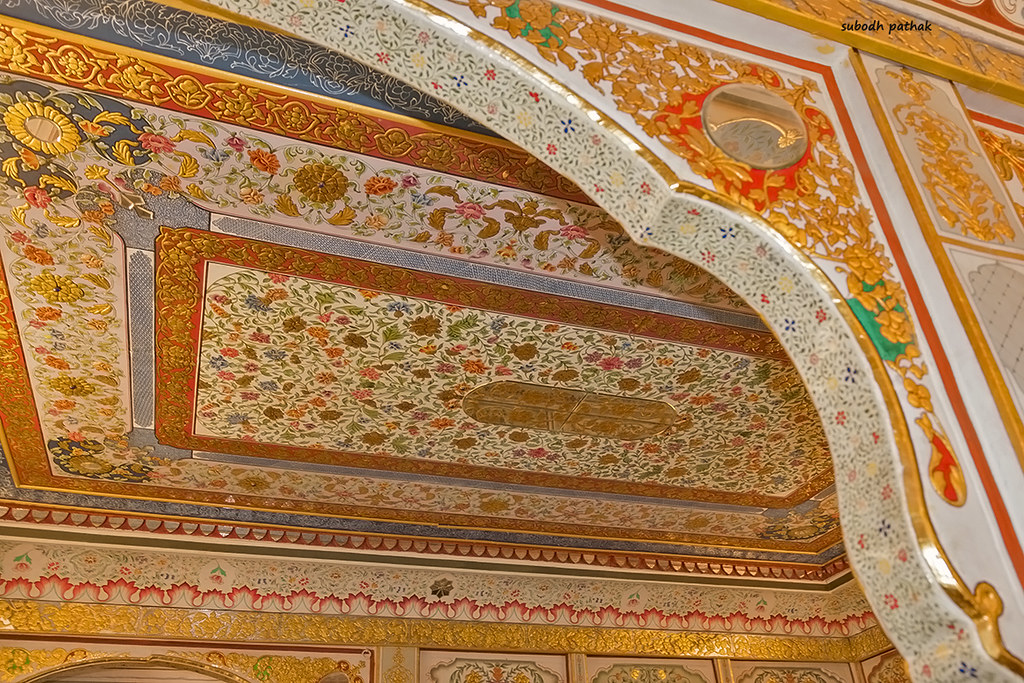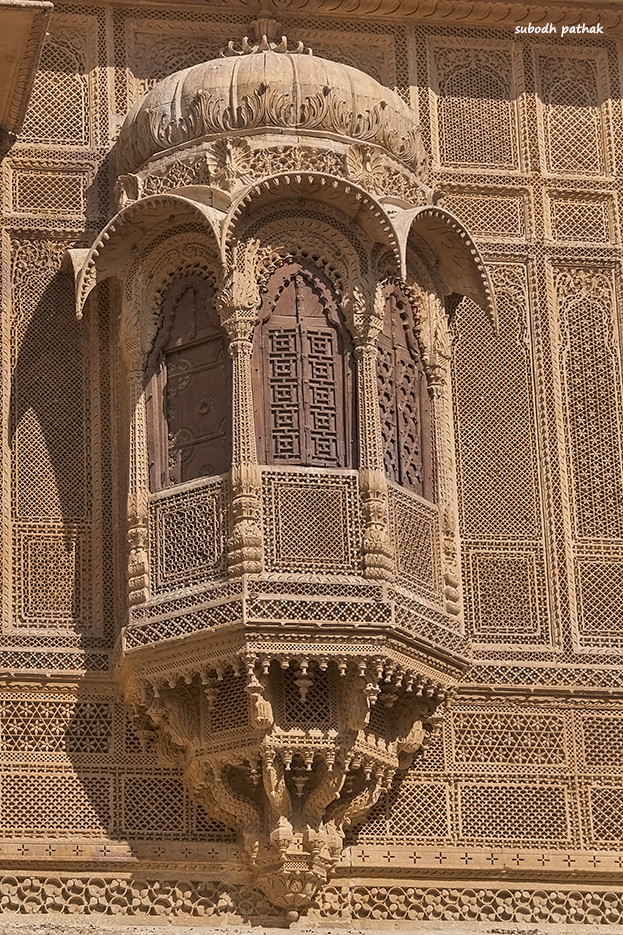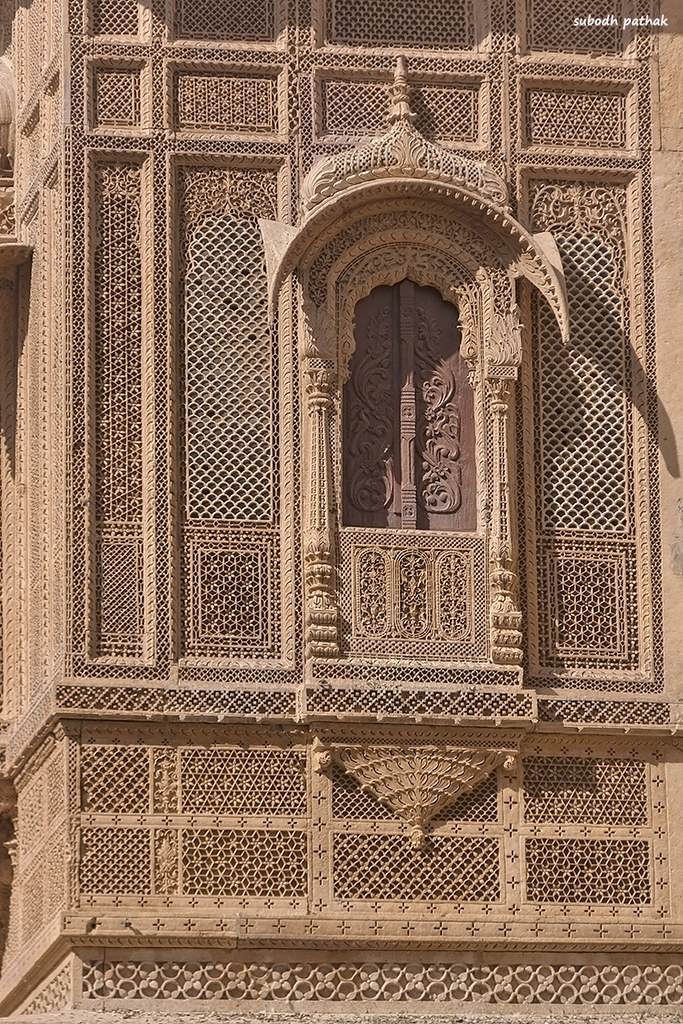Jaisalmer is a small town on the western border of India. Part of the state of Rajasthan. Famous for its Havelis.
The word Haveli is derived from Arabic word haveli means 'Partition' or 'Private Space' popularised under Mughal Empire and was devoid of any architectural affiliations. Later the owrd haveli came to be used as a generic terms for various styles of regional mansions, townhouse and temples found in India.
Jaisalmer was a major town controlling trade between India and Middle East. Traders here had riches to support an opulent lifestyle. The fact is reflected by richly decorated havelis of Jaisalmer. Sometimes these havelis are not a part of itinerary...but please please please...dont miss this marvel. Sacrifice your lunch time but do visit these havelis.
Patwon ki haveli is a major tourist attraction in Jaisalmer. This is group of 4 5 havelis in a narrow lane. Entrance looks as below.
Not all the havelis are open for tourists. The first one is the most decorated one and also open for tourists.First floor of the haveli has exquisite glass work and ceiling paintings. Can't call these fresco as fresco is the one painted rapidly on wet plaster.
Glass is an important medium used in Rajasthan. Availability of ample sunlight and preserving privacy (so that available light is reflected in the room) were the main reasons behind use of glass in the decoration.
Look at the peacock on the wall . You can also see a part of the wall open and without decoration. This was the hidden safe deposit vault. Concealed by a stone slab.
Facade looks something like this from a side view
These designs are created using actual gold foil. Remind you of Versailles Palace of France.
Patwa Haveli is a small museum. The family has displayed some old artefacts on display. This one is a traditional dress worn by the male and female on festival of Gan-gaur
Music room and some musical instruments
Once you come out of haveli, verandah is a place of activity. This used to be a place where visitors were greeted. Some children in traditional wear playing.
My lens could not accommodate entire view ....the facade is amazing carving.
Women of the house used to be under veil. The windows are wide open but blocked by intricate designs that blocked the inside view.
Verandah has some beautifully carved pillars.
These havelis are situated in a narrow lane blocking a complete single view of all the havelis together.
Balconies and designs of these balconies is another interesting feature of the havelis. Even the bottom of the balconies, an area which we normally do not notice is also carved intricately.
Too see the detailing and consistency in artwork, look at the pic below. You can see a different design for each square.
Outside haveli is a shoppers paradise....lot of handicraft items to choose from.
The word Haveli is derived from Arabic word haveli means 'Partition' or 'Private Space' popularised under Mughal Empire and was devoid of any architectural affiliations. Later the owrd haveli came to be used as a generic terms for various styles of regional mansions, townhouse and temples found in India.
Jaisalmer was a major town controlling trade between India and Middle East. Traders here had riches to support an opulent lifestyle. The fact is reflected by richly decorated havelis of Jaisalmer. Sometimes these havelis are not a part of itinerary...but please please please...dont miss this marvel. Sacrifice your lunch time but do visit these havelis.
Patwon ki haveli is a major tourist attraction in Jaisalmer. This is group of 4 5 havelis in a narrow lane. Entrance looks as below.
| View of the first haveli from below. This is exactly above the entrance verandah |
Not all the havelis are open for tourists. The first one is the most decorated one and also open for tourists.First floor of the haveli has exquisite glass work and ceiling paintings. Can't call these fresco as fresco is the one painted rapidly on wet plaster.
Glass is an important medium used in Rajasthan. Availability of ample sunlight and preserving privacy (so that available light is reflected in the room) were the main reasons behind use of glass in the decoration.
Look at the peacock on the wall . You can also see a part of the wall open and without decoration. This was the hidden safe deposit vault. Concealed by a stone slab.
Look at the internal galleries. Stones were friends to these craftsmen. Not a single inch left plain and without decoration.
Facade looks something like this from a side view
Roofs of some of the rooms are really worth watching. The golden colour you see is actual gold foil used in the paintings.
These designs are created using actual gold foil. Remind you of Versailles Palace of France.
Patwa Haveli is a small museum. The family has displayed some old artefacts on display. This one is a traditional dress worn by the male and female on festival of Gan-gaur
Music room and some musical instruments
Once you come out of haveli, verandah is a place of activity. This used to be a place where visitors were greeted. Some children in traditional wear playing.
Women of the house used to be under veil. The windows are wide open but blocked by intricate designs that blocked the inside view.
Verandah has some beautifully carved pillars.
These havelis are situated in a narrow lane blocking a complete single view of all the havelis together.
Balconies and designs of these balconies is another interesting feature of the havelis. Even the bottom of the balconies, an area which we normally do not notice is also carved intricately.
Too see the detailing and consistency in artwork, look at the pic below. You can see a different design for each square.
Outside haveli is a shoppers paradise....lot of handicraft items to choose from.





































No comments:
Post a Comment